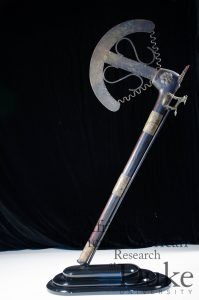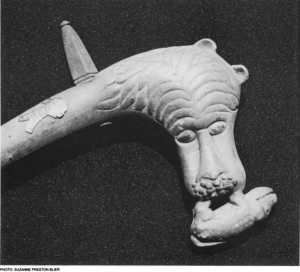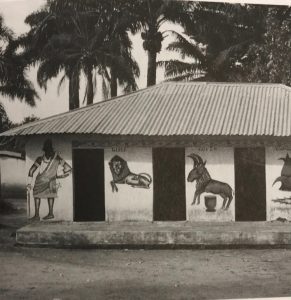Seth Epling
 The object was stuck in a falling state, suspended in mid air. A weapon among an altar, a scepter with crowns surrounding. I wanted to know where there was such a violent looking object in a place where everything else is full of color and life. The scepter does not stand out. It has little color and small designs that are worn away. The handle is simple, wooden staff. The kind of wood that if you held it, it would give you splinters. There are three brass segments on staff and right above the one at the top there is a cat like creature. It is a very interesting creature with a big cat body and long ears or horns. One of the biggest reasons why I picked this object is this animal and the shadow it casts. The shadow from the display makes it look like the cat is walking along the staff. Right before the axe head, two horns protrude, similar to the cat’s ears . There is the blade that is made of metal with tidal waves throughout the edge. Two metal pieces hold down the blade, an S shape metal piece and a spring piece. The last thing on the scepter is a flower a 6 petal flower below the horns and next to the head. On every other petal there are bumps that seem to make a simple pattern. This lead me to what I wanted to learn from this object. Why is this deadly object in a place of worship. Even within the scepter there are juxtapositions as there is a flower that draws your eye to it. I wanted to learn everything about this scepter and the god it represented, Hevioso or shungo. Contrary to its looks, it is not a weapon, it a tool used for religious and political festivals. I question the meaning behind with the aspects of the king and the deity he represented. As a hot god, Hevioso in vodou or Shungo in yoruba tradition, he does things quickly and people who have him as a deity are usually in power. This leads me to argue that this scepter was used to show power over the king’s followers. In the rest of the paper, I will give background on Hevioso and how a different king follows him and basic information on vodou and Yoruba tradition. Next I will talk about a king who was represented by the same god, Hevioso, King Glele and will then show how the scepter would be used in a festival based on first hand basis of people who research the religion. I will explain the cat creature on top of the staff and the significance it has towards the scepter.
The object was stuck in a falling state, suspended in mid air. A weapon among an altar, a scepter with crowns surrounding. I wanted to know where there was such a violent looking object in a place where everything else is full of color and life. The scepter does not stand out. It has little color and small designs that are worn away. The handle is simple, wooden staff. The kind of wood that if you held it, it would give you splinters. There are three brass segments on staff and right above the one at the top there is a cat like creature. It is a very interesting creature with a big cat body and long ears or horns. One of the biggest reasons why I picked this object is this animal and the shadow it casts. The shadow from the display makes it look like the cat is walking along the staff. Right before the axe head, two horns protrude, similar to the cat’s ears . There is the blade that is made of metal with tidal waves throughout the edge. Two metal pieces hold down the blade, an S shape metal piece and a spring piece. The last thing on the scepter is a flower a 6 petal flower below the horns and next to the head. On every other petal there are bumps that seem to make a simple pattern. This lead me to what I wanted to learn from this object. Why is this deadly object in a place of worship. Even within the scepter there are juxtapositions as there is a flower that draws your eye to it. I wanted to learn everything about this scepter and the god it represented, Hevioso or shungo. Contrary to its looks, it is not a weapon, it a tool used for religious and political festivals. I question the meaning behind with the aspects of the king and the deity he represented. As a hot god, Hevioso in vodou or Shungo in yoruba tradition, he does things quickly and people who have him as a deity are usually in power. This leads me to argue that this scepter was used to show power over the king’s followers. In the rest of the paper, I will give background on Hevioso and how a different king follows him and basic information on vodou and Yoruba tradition. Next I will talk about a king who was represented by the same god, Hevioso, King Glele and will then show how the scepter would be used in a festival based on first hand basis of people who research the religion. I will explain the cat creature on top of the staff and the significance it has towards the scepter.
In what is now the country of Benin, there was a kingdom named the Dahomey kingdom which ruled for around 300 years from 1600s-1900s. The main religion was Vodou, which is a religion based of the following of spirits. Some of these spirits are ancestral, but every person has a deity that guides that person through life. There were many kings that ruled over the Dahomey kingdom and each king had a deity that represented him or her. This is very similar to the religion of Yoruba. Many of the gods between these two religions have the same duties but have different names and have little differences. One god that many kings represented was Hevioso, the god of thunder for Vodou, is similar to Shogun, the god of thunder for Yoruba religion. “Hevioso is associated with the lightning-like gunfire and cannon during battle… Hevioso played an important role in war.” (Blier, 51). Hevioso is a god that likes to accomplish things quickly and effectively which is why many kings felt empowered by him. Hevioso is considered to be a hot god or petwo which is saying that he is an angry god but this is slightly wrong because they just did things fast and associated with war which is why they are perceived as angry. Often, Hevioso is represented as a lion because of his pride and his intensity. The king that was made for the scepter does not have information on him but there is another king, King Glele, that was much more influential who followed Hevioso in his actions.
King Glele was the king of Dahomey for many years, and like stated previously, he had Hevioso guiding him. He was a military genius and spent many of years of reigning on conquering other people. He earned the nickname of “Lion King” and “Lion of Lions”. Below is a court song about his reign.
“King Glele,
the one who cannot be taken
Lion of lions
The Animal grew teeth
and all the forest trembled
The animal that eats
the other animal with bones
The lion is afraid of no animal” (Blier, 52)
People were afraid of King Glele and this is what this court song was saying. Fon people, the people who follow vodou in Benin, admired him but because of his actions, that were guided by Hevioso, they were taught not to wrong him. He was a fearsome ruler and stayed in power because of the fear he inflicted on people. He would not go around hurting his own people, but because of the vodou religion and the implication of him having Hevioso as his deity

Shown above is one of the scepter made for King Glele taken by Blier. It has many similar aspects to the scepter in the museum. The creature on top of our scepter has similar facial expressions and shape to this one. King Glele commissioned the making of many objects like this including big knives. According to Adjaho in Bliers writing, the making of the knives is to show great amount of force and that there would always vengeance.
These knives made for King Glele and the scepter that I am examining seem to be used in the same festivals and courts. For one they were used in the court systems, these objects were used as tribute to the royal dead, punish criminals, promote and pay court officials, celebrate military victory and display wealth of the royal family according to Blier. These knifes and the scepter are used as a way to show strength both physical and personal. For the king to show how much power and money he has, to demonstrate the greatness of his armies when they won. It was just to prove to the people that he is most supreme. This is interesting because one of the major viewpoints of the haitian religion is healing the body and soul. There doesn’t seem to be festivals or courts that use either these knives or the scepter that convey a main theme of health. They do have a belief that “People are born to die” (Brown, 4) and these objects are used to celebrate the deaths of a royal family. They seem to be used more in honor of the fallen, as in war or royally, then to be used in healing the body.
The reason for the cat creature towards the head of the staff is a little tough. Since there is no information on the king who kept this scepter, it is hard to know what exactly is the creature. In the picture of the Nesuhwe shrine house in Abomey from the book Asen, Ancestors, and Vodun there are two animals. The lion with a name above it that says Glele
Photo by E. Bay

which is his animal that represents him and next to him on the right side, there what seems to be a cat like animal with horns for Glele’s father, Ghezo. This animal is thought to be a buffalo because one part of his symbol is a buffalo, according to the new world encyclopedia. Using this information, I can infer that this animal, if it is a cat, buffalo, or anything that is aggressive and strong, is unique to the king that had this scepter and also a form of representing and honoring Hevioso.
I went into this research with the goal of figuring out what the scepter was used for and how it related to Hevioso. Unfortunately, not knowing what king had possession of the scepter made the research difficult. I was able to use King Glele who had the same deity and his father to infer multiple points. I was able to argue that the scepter was used to scare people and keep them below him or her. I was able to explain multiple parts of the scepter and how they related to Dahomey kingdom of the Fon culture. This just shows that it is hard to take any object out of context and expect to understand it fully. This goes along with any diasporic religion, the only way of full understanding of an object, it has to be seen in use at a ritual.
Bibliography
Bay, Edna G. Asen, Ancestors, and Vodun. Chicago: University of Illinois Press, 2008.
Blier, Suzanne P. “King Glele of Danhomè, Part One: Divination Portraits of a Lion King and
Man of Iron.” African Art 23, no. 4 (October 1990): 42-53. JSTOR (3336943).
Brown, Karen M. Vodou in Haitian Life and Culture. Basingstoke, United Kingdom: Palgrave Macmillan Accessed October 30,
2017.
“Kingdom of Dahomey.” New World Encyclopedia , Edited by Frank Kaufmann, 11 May 2015,
www.newworldencyclopedia.org/entry/Kingdom_of_Dahomey.